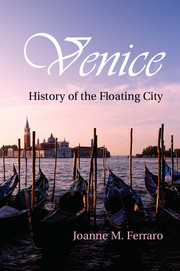Book contents
- Frontmatter
- Contents
- Plates
- Illustrations
- Maps
- Acknowledgments
- Preface
- Chronology of Historical Events
- 1 Reconstructing the Floating City
- 2 The Riches of Asia, Europe, and North Africa
- 3 A Pride of Lions
- 4 Identities and Modes of Socialization
- 5 Material Life
- 6 City of Myth
- 7 The Serenissima’s Wayward Subjects
- 8 The Baroque Stage
- 9 Epilogue
- Appendix I Approximate Population of Venice during the Republic
- Appendix II Population of the Historic Center of Venice, 1871–2010
- Glossary
- Notes
- Bibliography
- Index
- Plate Section
- References
7 - The Serenissima’s Wayward Subjects
Published online by Cambridge University Press: 05 August 2012
- Frontmatter
- Contents
- Plates
- Illustrations
- Maps
- Acknowledgments
- Preface
- Chronology of Historical Events
- 1 Reconstructing the Floating City
- 2 The Riches of Asia, Europe, and North Africa
- 3 A Pride of Lions
- 4 Identities and Modes of Socialization
- 5 Material Life
- 6 City of Myth
- 7 The Serenissima’s Wayward Subjects
- 8 The Baroque Stage
- 9 Epilogue
- Appendix I Approximate Population of Venice during the Republic
- Appendix II Population of the Historic Center of Venice, 1871–2010
- Glossary
- Notes
- Bibliography
- Index
- Plate Section
- References
Summary
The Age of Religious Dissent
The myth of an ideal Republic of enduring stability, clearly articulated in the pageantry, music, and visual arts, was a calculated antidote to the city’s underlying disorders, which magistrates defined in social and gendered terms. Moreover, the imagination offered flight from the religious and political subversion sweeping across much of Europe during the sixteenth and seventeenth centuries. To the north, in Wittenberg, an ardent Augustinian monk named Martin Luther, calling for church reform in 1517, had by 1521 unwittingly started the new Lutheran religion, rupturing nearly a thousand years of Roman Catholic unity. Further religions schisms soon followed throughout the Holy Roman Empire. Then, during the 1530s, Jean Calvin initiated a second wave of protest, this one more militant, in the Swiss cantons, and by mid-century Calvinism was spreading rapidly to disaffected elites in France and the Spanish Netherlands. Catholic prelates began to take up reform in 1545, convening for nearly two decades in the city of Trent to study how to improve the priesthood, care for the sick and poor, and preserve the sanctity of marriage. They also strictly affirmed traditional Catholic doctrine. But by this time the followers of Protestant beliefs were entrenched and encroaching on Catholic lands. As a result, religious wars racked most of Europe well into the seventeenth century. Protesters’ differences with the Catholic Church did not stop with theology, but rather with the entire way society was organized. Seeking freedom of religious worship but also to throw off the yoke of class difference, diverse groups with different aspirations temporarily joined together. The Venetian state and local church, of course, sided with the Catholics, staging celebratory feasts when they obtained victories over the Huguenots in 1563 and the Ottoman Turks at Lepanto in 1571.
- Type
- Chapter
- Information
- VeniceHistory of the Floating City, pp. 151 - 173Publisher: Cambridge University PressPrint publication year: 2012



